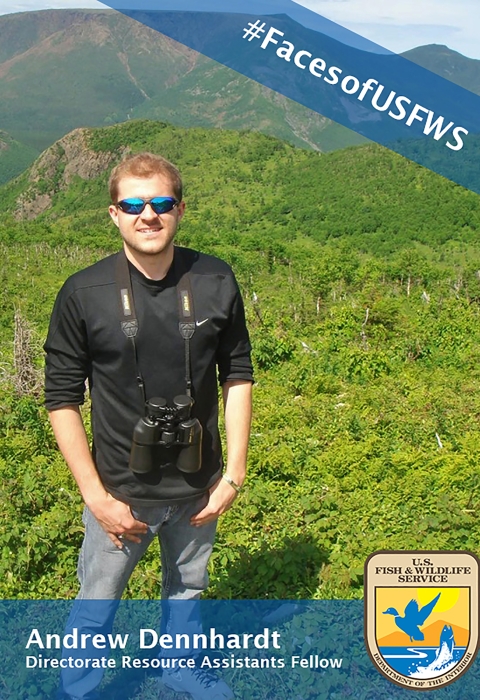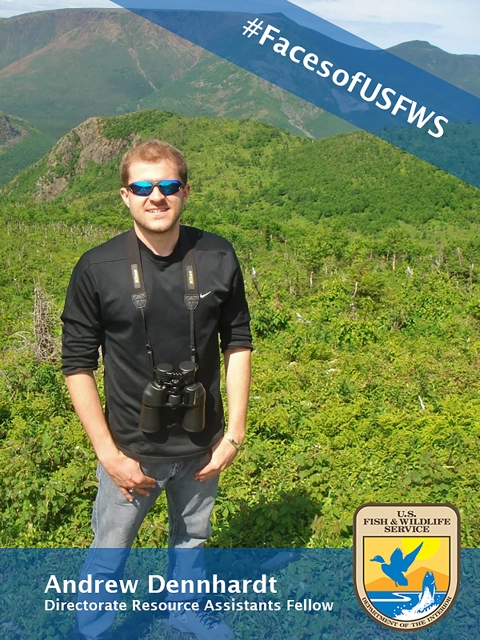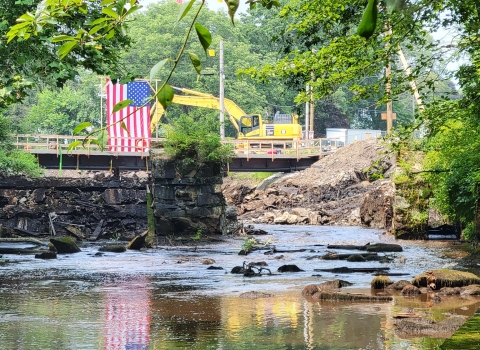We like to share the insider's scoop about the people who carry out the important work of protecting and conserving fish, wildlife, plants, and their habitats along the central and Southern California coast. Meet one of U.S. Fish and Wildlife Service Directorate Resource Assistants Fellows, Andrew Dennhardt:
What led you to a career with the U.S. Fish and Wildlife Service?
My passion for people, research, education, and wildlife conservation led me to a summer fellowship with the Service, and I look forward to transitioning this position into a lifelong career with the Service. Growing up with self-proclaimed “land stewards” as parents, our family visited many conservation festivals together, and one particular celebration, called “Bald Eagle Days,” first introduced me to local agents of the Service as well as to their daily work with and passions for wildlife. Early on, I knew that I wanted to explore this agency more in the future, and I have now been afforded the unique opportunity to do so as part of my summer fellowship experience. I am especially grateful to the Service’s Directorate for sponsoring such an incredible program for both undergraduate and graduate students, early-career folks just as passionate about addressing today’s conservation challenges.
What role do you play within the agency?
I work in Ecological Services as part of the Listing and Recovery Division in the Ventura, California field office. My primary role is to develop a draft management and monitoring plan for the federally-endangered least Bell’s vireo in the Santa Clara River watershed of Southern California, a potential source location for helping populate other historically-occupied areas of the vireo’s range. Further exploring the agency, my secondary roles involve sitting in on various topic-relevant meetings and assisting my coworkers with scientific outreach programs and other projects.
Where did you go to school and what did you study, and/or for which military branch did you serve and in what capacity?
I received my Bachelor’s degree in Zoology, with a minor in Environmental Studies, from Southern Illinois University, during which I researched natal dispersal in peregrine falcons of the U.S. Midwest. Later, I received my Master’s degree in Wildlife and Fisheries Resources from West Virginia University, during which I researched the migration and population ecology of golden eagles in eastern North America. In the near future, I will be completing my doctoral degrees in Fisheries and Wildlife as well as Ecology, Evolutionary Biology, and Behavior at Michigan State University, and my dissertation research describes multi-year fish and landbird community responses to environmental and anthropogenic factors in the Great Lakes region.
Of all the species our agency works to protect along the central California coast, which is your favorite? Why?
The California condor is my favorite species that our agency works to protect along the central California coast. Not only do I favor these condors because I am a raptor fanatic, but I also favor them for their incredible life history and conservation story. These Pleistocene-period birds are one of the largest and most powerful soaring raptors in the world, which readily warrants our protection and appreciation. Despite their awesome appeal, these birds are also very sensitive to lead poisoning. These and other reasons make California condors exciting to research, protect, and conserve here in Region 8.
Tell us about a particular project from your career or schooling that makes you really proud.
My Master’s research was quite the challenge in its day. For the first time in my education, I was asked to code computer programs, particularly those that would predict the migration patterns of a rare soaring raptor in response to updrafts in the environment. To boot, I was also tasked with collating historic records on sightings of these rare birds across a large geographic region, in order to later integrate such records with relevant outputs from my migration simulations. Together, these data would be used to generate population abundance estimates for the region, and with the help of several mentors and other collaborators, I found a way to do just that. After first witnessing the scientific community receive and later cite my work, I have never felt so proud of a personal accomplishment.
How do you spend your free time?
During my free time, I like to partake in sports such as hunting, fishing, hiking, football, biking, volleyball, ultimate frisbee, softball, and basketball. Given my love of raptors and other birds, I also enjoy getting out to observe our feathered friends in wild places every now and then.
Do you have a hidden talent? If so, what is it?
I am not ashamed to admit that I like to impersonate animals and sometimes other people. I also like to think that I am pretty good at it, depending on the subject of my flattering imitations. Perhaps the best proof of my skills in this area is that several years ago, I was told by my supervisors at the time that one of the main reasons they had hired me for one of the technician positions at our consulting company was because a former supervisor of mine at the U.S. Forest Service had told them that, during a reference call, I was “an excellent replicator of owl calls.” Needless to say, I had a real hoot that summer surveying the California Redwood Coast for Northern spotted owls, and I often did not need to use the electronic callers. Those were the days!



